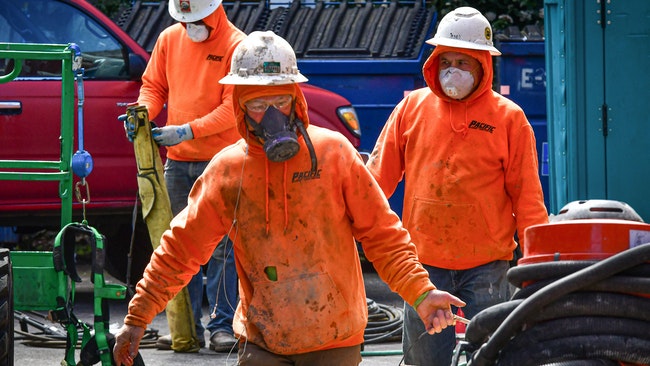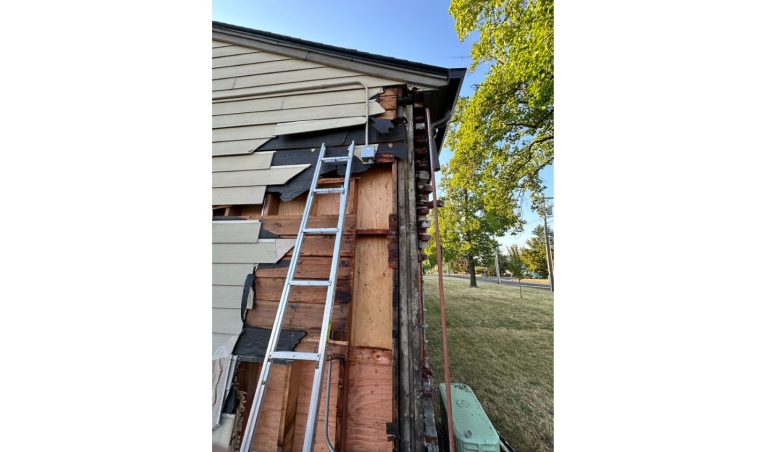Oregon workplace safety agency moves to make Covid regulations permanent


Masks and protective gear are part of the job as laborers in essential fields continue working. (Ron Cooper/Salem Reporter)
Gov. Kate Brown has hinted that many Covid restrictions that have become part of daily life could be relaxed as soon as this summer.
But the state’s worker safety agency has adopted workplace regulations that’ll be in place indefinitely.
On May 4, the Oregon Occupational Safety and Health Administration enacted a rule that’ll make permanent many of the masking, sanitization and social distancing requirements that have been in place since earlier in the pandemic. A week earlier, the agency adopted another permanent regulation aimed at preventing the spread of Covid in employer-provided housing.
Both sets of regulations replace temporary rules and were written after months of public input. While business groups say the regulations are manageable, although costly and cumbersome, they particularly chafe at the agency setting no sunset date for them. Others have expressed annoyance.
“Unbelievable,” said Marion County Commissioner Danielle Bethell in a Facebook post earlier this week. “I don’t know why I’m even annoyed, of course OSHA could care less about the 5,000 voices who weighed in against this idea.”
Labor groups say the extended rules are a continuation of what employers have been doing for the last year, which they say have kept workers safe.
Miles Eshaia, spokesman for United Food and Commercial Workers Local 555, also said the regulations are largely just an extension of the rules that have been in place for months. They won’t be hard to implement and, if followed properly, will keep workers safe, he said.
“Don’t forget that we are actually in a pandemic, and you have to follow the rules and you have to keep going,” he said.
In a statement announcing the broader set of workplace regulations, Oregon OSHA explained that state law doesn’t allow temporary rules to be in place for more than 180 days.
“To allow the workplace COVID-19 protections to simply go away would have left workers far less protected,” said Michael Wood, administrator of Oregon OSHA. “And it would have left employers who want to know what is expected of them with a good deal less clarity than the rule provides.”
According to the statement, Oregon OSHA will consult with the Oregon Health Authority, as well as multiple advisory panels and stakeholders to determine when it’s safe to relax the regulations. The agency will consider infection rates, vaccinations, variants of the virus, as well as hospitalizations and fatalities. Oregon OSHA will revisit the regulations in July and every two months afterward, according to the statement.
“Many of our small business members have told us that these rules have been quite costly and burdensome so they are eager for a day when the rules are no longer needed and we can focus our energies on restoring Oregon’s economy,” said Paloma Sparks, vice president of government affairs at Oregon Business and Industry, in a statement.
She said her group has prioritized workplace safety and has a good relationship with OSHA.
The new regulations are lighter than the temporary ones by about 50 pages. Gone are requirements for schools to keep students in cohorts and physical distancing. Employers aren’t required to transport workers in separate vehicles (but are encouraged to) and must make sure their ventilation systems are running correctly.
Employers don’t have to sanitize surfaces as much as previously, in accordance with updated Centers for Disease Control and Prevention guidance. Workers exposed to Covid must still quarantine, but now must also be told by employers when it’s safe to return to their previous job duties.
Oregon OSHA has also adopted permanent regulations in a more focused workplace setting: employer-provided housing. Last May, the agency enacted regulations intended to ensure social distancing and sanitization in employer-provided housing. Specifically, they mandated that fewer employees could be in employer-provided dwellings or transportation at the same time, along with increased sanitization requirements.
Last week, the agency adopted a similar set of regulations permanently.
The regulations have had a particular effect on farms that offer to house seasonal employees.
Samantha Bayer, policy counsel for the Oregon Farm Bureau, said there are over 300 registered units of employer-provided housing at agricultural operations in Oregon. Marion County has the largest agricultural output of any county in the state.
“I think we will be able to work with these,” she said of the regulations. “They are not perfect, but they are an improvement.”
She said there are some positives in the new set of regulations. Farms are now required to sanitize housing areas only once a day instead of three times, which she called “beyond excessive.” Employees are also encouraged to clean their personal areas, she said. Employers must have an infection-control plan that includes how to bring in public health authorities in case of an outbreak, which she said provides clarity for farms.
The biggest concern of the Oregon Farm Bureau has been keeping workers in employer housing instead of unregulated environments where the virus can more easily spread, she said. The regulations have decreased the number of workers that can be housed, significantly cutting into the workforces of some farms, she said.
Farms can house more workers in dwellings with increased ventilation under the regulations. But Bayer said the filters are an added cost and the regulations still don’t allow more vaccinated employees to be housed together. She also criticized how the regulations don’t have a clear sunset date.
Reyna Lopez, the executive director of Woodburn-based Pineros y Campesinos Unidos del Noroeste, said that some farms adjusted to the rules by bringing in tents, RVs or other temporary housing to space workers out.
She said that every worker she’s talked to told her that the regulations made for safer working environments. Oregon’s low rate of infection and death from Covid is because of rules like this, she said.
“I think that these are just very important protocols to keep people safe,” she said. “We are in the pandemic of the century. This disrupted everyone’s lives.”
Contact reporter Jake Thomas at 503-575-1251 or [email protected] or @jakethomas2009.
BE PART OF OUR TEAM FOR SALEM’S BENEFIT: Accurate local information is vital for any community and that’s harder to come by in this day of “anyone can post anything” to social media. People in communities without trained journalists working for them don’t have accurate, trusted information. Help Salem avoid that fate – join in putting fuel in the tank of Salem Reporter to keep it growing, going strong. Here’s how:
SUBSCRIBE: A monthly digital subscription starts at $5 a month.
GIFT: Give someone you know a subscription.
ONE-TIME PAYMENT: Contribute any amount and you support giving the people of Salem local news otherwise missing. (You can also mail your contribution: Salem Reporter, 72585 Middle Fork Lane, Bates OR 97817)



